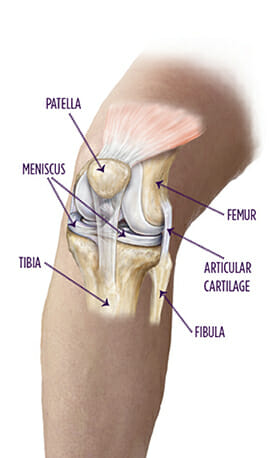What is Knee Arthroscopy?
Arthroscopy is a surgical procedure that uses several small incisions to access the inside of your knee with a tiny camera and specialized instruments inserted into the joint space. Using arthroscopy, your doctor can confirm your diagnosis and repair any injured tissue.
What Happens During a Knee Arthroscopy?
Although every patient is different, here is what typically happens during a knee arthroscopy procedure:
- Your doctor makes two to three small incisions
- Tools are placed inside the knee through the incisions
- A small fiber-optic camera lets your surgeon visualize the injury and confirm your diagnosis
- A shaver, trimmer or any other device necessary to repair your knee is inserted opposite the camera
- Sometimes a third tool irrigates the joint and, if necessary, expands it

What are the Risks of Knee Arthroscopy?
As with any surgery, arthroscopy has risks. These include, but are not limited to:
- Swelling and stiffness
- Blood clots
- Bleeding
- Infection
- Continuing knee problems
What Can I Expect Before Knee Arthroscopy?
You will need a preoperative physical performed by your primary care provider within 30 days before surgery. If you do not have this done, we will have to cancel and reschedule your surgery.
What Can I Expect After Knee Arthroscopy?
Here is what happens after your knee arthroscopy procedure:
- Immediately after surgery, you will be placed in a recovery room and monitored by a nurse.
- You can expect your knee to be bandaged and elevated.
- If after several hours you are awake and alert, a nurse will help you get ready to go home.
- You will need to arrange for someone to drive you home.
- Some patients feel comfortable walking out of surgery, while others wish to use crutches.
What Can I Expect While I am Recovering at Home After Knee Arthroscopy?
- You should rest, ice, elevate, and perform gentle exercises as directed for your knee.
- Do not spend an extended amount of time standing, walking, or taking trips up and down stairs during this time, since too much movement can cause your knee to become more painful and swollen.
- Medication will be prescribed to you for the postoperative pain. It is your responsibility to have the prescription filled.
- Before surgery, your physician will schedule a postoperative clinic visit. At this visit, you will discuss the surgical procedure and findings, physical therapy, and further activity guidelines.
What Is Cold Compression Therapy, and Why Did My Doctor Recommend It?
Your doctor may prescribe a cold compression therapy unit for you to use after your surgery. Integrated cold and compression is clinically proven to:
- Reduce postoperative swelling
- Decrease pain
- Help you regain range of motion
Summit Orthopedics believes that the cold compression therapy unit will provide you with the best possible outcome in the days following your surgery.
How Long Will It Take to Recover From Knee Arthroscopy?
The length of your recovery can vary, so talk with your orthopedic surgeon about the recovery plan for your specific situation.
